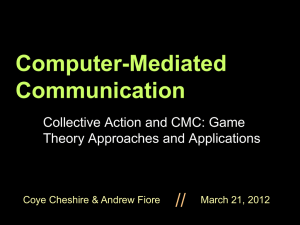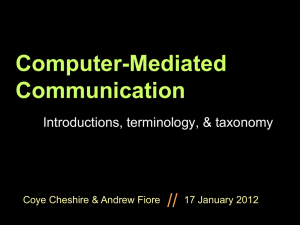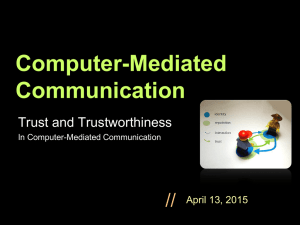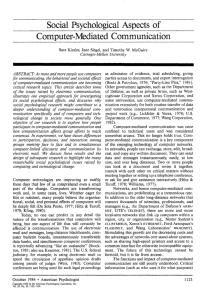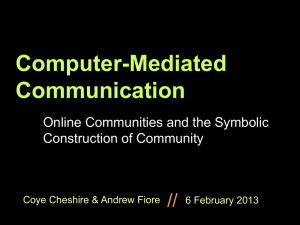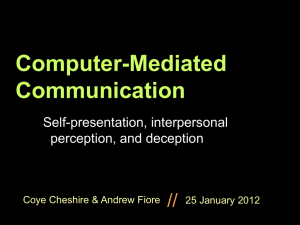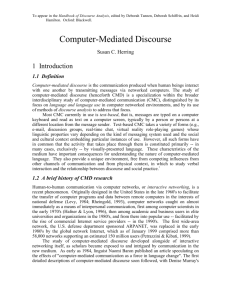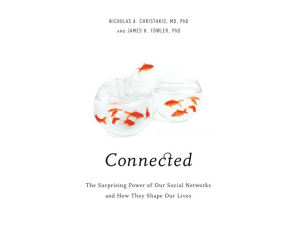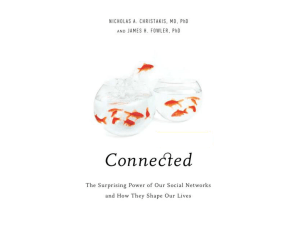slides - Courses
advertisement
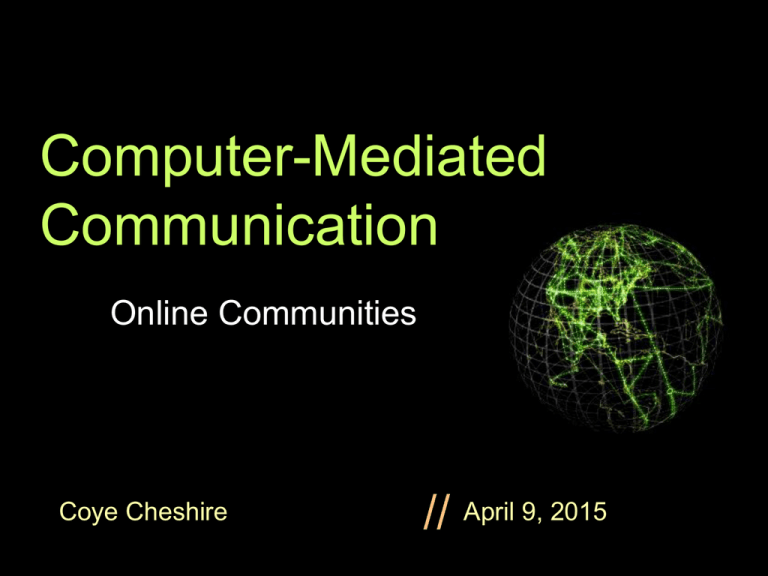
Computer-Mediated Communication Online Communities Coye Cheshire // April 9, 2015 Some key terms from Cohen Symbol: the means to make meaning Subjectivity: to each her own interpretation Community: inclusion, exclusion, and … ??? Simplexity and multiplexity: like weak and strong ties 4/9/2015 Computer-Mediated Communication 1 Community Boundaries Revisited: Ye old Facebook Fiasco of ‘06 “The point is, you're always presenting the identity you want to present - you never have to worry about the identity you used to present … This morning, millions of students were shown that they can't actually rewrite history. Everything they do, all of the groups they join and interests they state or friends they make - it is all being recorded.” (Fred Stutzman) 4/9/2015 Computer-Mediated Communication 2 So what makes a community? Common practices? Network ties? Symbols? Poster to post ratio? 4/9/2015 Computer-Mediated Communication Affect-laden relationships? 3 The Beginnings of Online Community… Or, “Why Usenet ???” The first large-scale online communities were Usenet discussion groups and forums - Developed around 1979 - No official structure Red Letter Dates! http://www.google.com/googlegroups/archive_announce_20.html 4/9/2015 Computer-Mediated Communication 4 http://www.ischool.berkeley.edu/~atf/images/treemap_all.gif 4/9/2015 Computer-Mediated Communication 5 One View on Virtual Communities… Jones (1997) Four Qualities that characterize virtual communities: A minimum level of interactivity A variety of communicators Common public space A minimum level of sustained membership 4/9/2015 Computer-Mediated Communication 6 And Another view… (Chromatic, from O’reilly Network) http://www.oreillynet.com/pub/a/network/2002/10/21/community.html Exist for a reason Users draw other users Users will surprise you A sense of ownership A shared history and culture Role of Mischief Barriers are mixed blessings Discuss the Community Openly 4/9/2015 Computer-Mediated Communication 7 Social Networks and Online Community “Community emerges where the cumulative impact of interactions among individuals adds value above the level of pairwise interactions” - Caroline Haythornthwaite 4/9/2015 Computer-Mediated Communication 8 The network perspective People (nodes) Ties (edges) 4/9/2015 Computer-Mediated Communication 9 Ties in a social network Directed or undirected Simplex or multiplex Valued or unvalued 7 4/9/2015 Computer-Mediated Communication 10 Network Approach to Community Examines interconnections to discover where groups exist rather than determining a priori that a group exists based on external criteria. But is this a community? Or “an alliance, a collaborative work group, a collective, a cohort”? 4/9/2015 Computer-Mediated Communication 11 The power of social capital 1+1=2 1 + 1 > 2? 2 + 2 > 4? Fully connected network: N people, N(N-1)/2 ties Connections grow at a much faster rate (quadratic vs. linear) Bridge 6 + 6 > 12? 4/9/2015 Computer-Mediated Communication 12 Other Community Types Communities of Practice Link-Based Communities 4/9/2015 Computer-Mediated Communication 13 Community lost Community saved Community liberated 4/9/2015 Computer-Mediated Communication 14 The Nature and Function of Online Groups 4/9/2015 Computer-Mediated Communication 15 Different goals, same behavior, different outcomes. Different motivational processes, same consequences. 4/9/2015 Computer-Mediated Communication 16 Other Points (inspired from your reviews) Role of “misunderstandings” and sense-making in groups with limited information “Why?” (Kimra McPherson 2010) 4/9/2015 Computer-Mediated Communication 17 Shyness 4/9/2015 Computer-Mediated Communication 18 Aggressiveness 4/9/2015 Computer-Mediated Communication 19 Types of online groups (McKenna) Organizational groups Social groups Common bond Common identity Stigmatized-population groups Support groups 4/9/2015 Computer-Mediated Communication 20 Group Dynamics Leadership Status Power 4/9/2015 Computer-Mediated Communication 21 Online communities are neither built nor do they just emerge, they evolve organically and change over time. Developers cannot control online community development but they can influence it. Jenny Preece 4/9/2015 Computer-Mediated Communication 22 A few more Final Project Examples… A Design Annotation Tool Design Considerations for Collaborative Visual Analytics 4/9/2015 Computer-Mediated Communication 23
